|
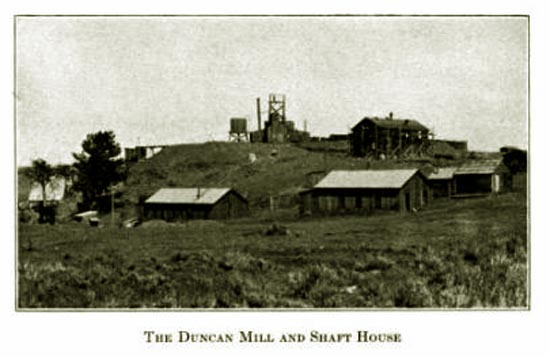
Duncan Mine, South Pass City, 1911.
Not withstanding the Indian problems, in 1868 Jim Duncan opened the Duncan Mine. Several others mines opened and
four stamp mills were constructed.
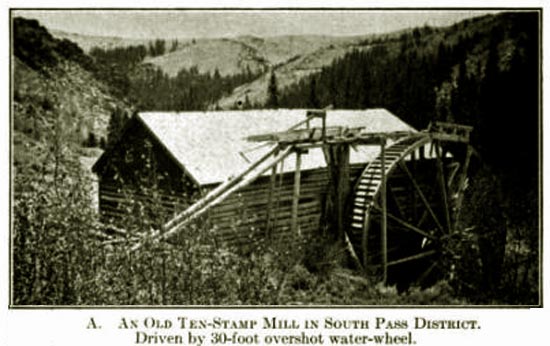
Overshot powered 10 stamp mill, South Pass City.
In an entreaty for a post office, it was reported that by March of 1868, the town had a population of 1,000 and it was anticipated that within one or
two months, the town would have 3,000. A postal agent from Salt Lake City estimated that within a few months thereafter,
the City would attain a population of 10,000. Indeed, however, there was a need
for a post office. It cost $1.00 to send a letter by private express. The road from
Sweetwater to South Pass City passed over a 75 mile stretch of arid desert, "destitute of water."
George W. B. Dixson (1844-1925) was named as postmaster. Soon, however, he absconded with some of the government's money, allegedly to
the newly found diamond fields of Cape Colony. There he remained until after his wife died. He ultimately
returned to the United States and died in Chicago in 1925.
Much, however, was hyperbole. W. G. Smith reported that there was a population of 3,000 or 4,000 in the
region, but the city consisted of "some eight or ten buildings partially completed at South Pass
City, and the chief occupation of those consists in the endeavor to sell lots or quartz
lodes to new comers."
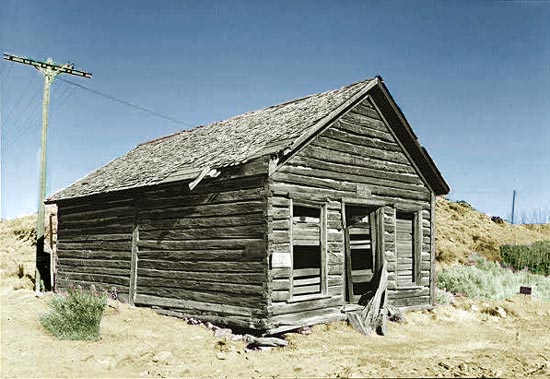
Remains of dance hall, South Pass City.
James Chisholm, in his Journal reported an 1868 populatin of 50 or 60. In some
instances the sale of lodes was very profitable. In 1868, the Young American mine, owned by
George Arnett and Francis "Vinegar" Zernier, was sold for $50,000. Zernier, a German with very thick accent, later was to
be among the initiates to the cemetery when he was killed by freighter Sam Fairfield.
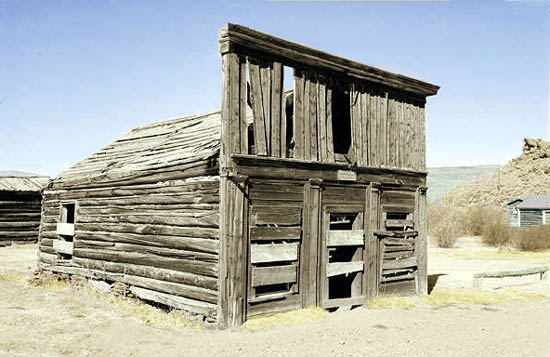
Remains of a commercial building at intersection of
Grant Avenue and Price Street .
Nevertheless, in short order the town had a newspaper, five hotels and some fifteen saloons including the "49'er," the Keg, the
Magnolia, the Elephant Saloon and the Occidental.
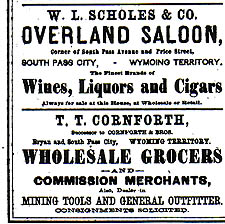 Advertisements for South Pass businesses in the 1869 Salt Lake City Directory
Advertisements for South Pass businesses in the 1869 Salt Lake City Directory
The town was designated by the Dakota Territorial Legislature as the county seat of Carter County, named after Judge Wm.
Carter of Fort Bridger. Later, after the formation of Wyoming Territory, the county was renamed Sweetwater County. By 1868, the town had
stage service south to Bryan on the Union Pacific. By 1869, Iliff & Co. had opened the Exchange Bank.
A toll road to Atlantic City 2 1/2 miles away was opened, tolls:
fifty cents for a wagon and two horses, twenty-five cents for two horses, and stray
stock five cents each.
If the growth
of South Pass City was rapid, its decline was equally fast. By 1870 the bank closed. In 1871 there was a disasterous fire. The gold rush
ended by 1873 and the Carissa was idled. Governor J. W. Hoyt reported in 1878
that "South Pass is a scene of vacant dwellings, saloons, shops, and abandoned gulches."
For some who came and left, fortune or the big strike was just over the next hill. Such was English-born Thomas T. Cornforth (1843-1927) whose
mercantile establish is advertised to the left. Cornforth at the age of 18 was a freighter carrying
goods from the Missouri River to Denver. He was among the first to set up in Cheyenne when the
railroad arrived. He then followed the Railroad from one end of tracks town to another, Benton, Bryan and
Wasatch. He then moved to newly founded South Pass City. When it failed he returned to
Cheyenne hauling supplies to Fort D. A. Russell. And like many others when the gold rush hit
Deadwood City, he was there selling tinned oysters and filing a claim at Lexington Hill. By 1880, a new
gold rush hit Leadville and soon he was there. By 1890, Leadville had fizzled and he was involved in
a farm grown fish and frog leg scheme in Provo and was a distributor of oysters in Denver. Hope spings eternal. In 1918 at age 75, Cornforth was involved with
oil claims in Greybull.
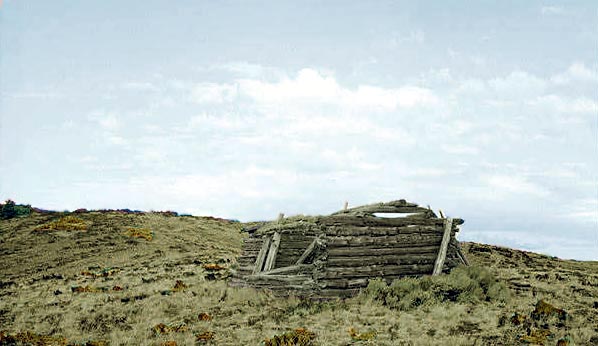
Remains of the Carrie Shields Mine.
The Carrie Shields Lode was discovered by Archie Turner in 1867. Turner had arrived in South
Pass City from Boise, Idaho. There he had run for the congressional delegate seat but was defeated by the brother of
Jack Holbrook, one of the discoverers of the Miners Delight Mine. His fellow miners in South Pass sent him to the
Dakota Territory capital in Yankton to lobby for the passage of a law favorable to mining. He was
apparently unsuccessful but came home with the consolation prize of the formation of Carter County and himself
as County Recorder. The Carrie Shields was sold to W. C. Ervin who for a while owned the
Idaho House, later renamed the Sherlock Hotel. Archie Turner later continued his search for gold in the
canyonlands of Utah.
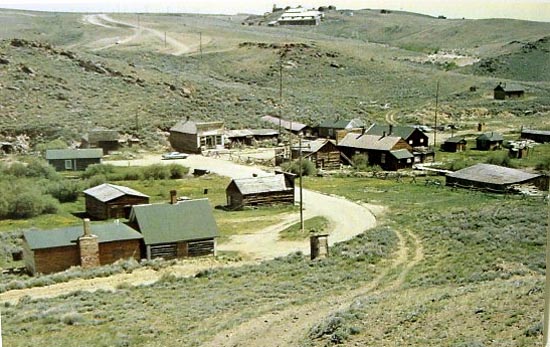
South Pass City.
Next page: South Pass City continued, Women's Sufferage.
|